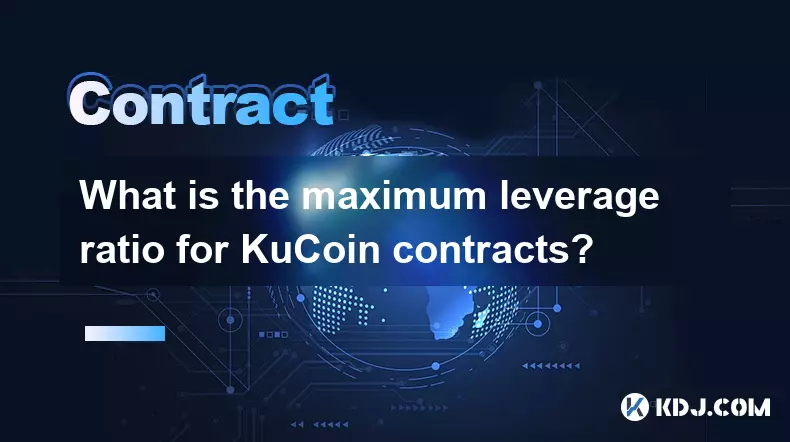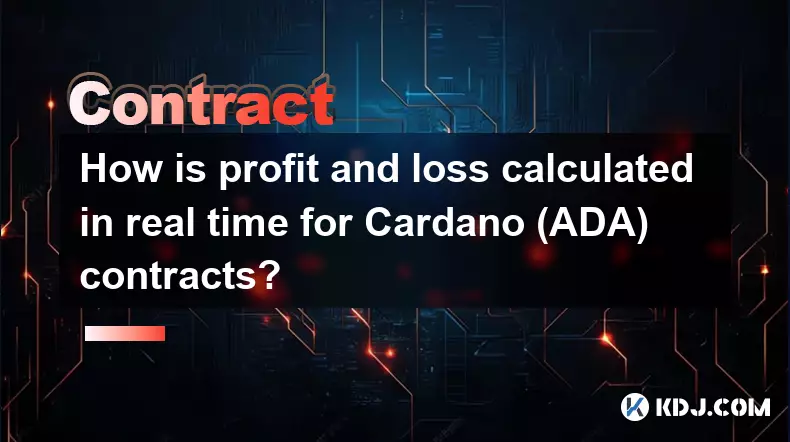-
 bitcoin
bitcoin $109667.069529 USD
-3.03% -
 ethereum
ethereum $3936.685804 USD
-4.07% -
 tether
tether $1.000493 USD
0.01% -
 xrp
xrp $2.771823 USD
-4.74% -
 bnb
bnb $957.805027 USD
-5.34% -
 solana
solana $196.735100 USD
-6.68% -
 usd-coin
usd-coin $0.999727 USD
-0.01% -
 dogecoin
dogecoin $0.227355 USD
-5.12% -
 tron
tron $0.335205 USD
-0.81% -
 cardano
cardano $0.779256 USD
-3.59% -
 ethena-usde
ethena-usde $0.999900 USD
-0.06% -
 hyperliquid
hyperliquid $42.492095 USD
-6.61% -
 chainlink
chainlink $20.501853 USD
-4.34% -
 avalanche
avalanche $28.952606 USD
-11.21% -
 stellar
stellar $0.356038 USD
-3.93%
What is the maximum leverage ratio for KuCoin contracts?
KuCoin offers up to 100x leverage on major crypto futures like BTC and ETH, with lower limits for altcoins, subject to risk, liquidity, and user tier.
Sep 19, 2025 at 10:54 am

Understanding KuCoin Futures Leverage Limits
1. KuCoin offers leveraged trading across a wide range of cryptocurrency perpetual and futures contracts. The maximum leverage available depends on the specific asset being traded and its market volatility. For major cryptocurrencies like Bitcoin (BTC) and Ethereum (ETH), traders can access up to 100x leverage. This high level of exposure allows both experienced and speculative traders to amplify their positions significantly.
2. Altcoin futures typically have lower maximum leverage compared to flagship assets. For example, smaller-cap tokens such as Dogecoin (DOGE) or Shiba Inu (SHIB) may be capped at 50x or 75x leverage, depending on liquidity and risk parameters set by KuCoin’s risk engine. These limits are dynamically adjusted based on real-time market conditions and historical price swings.
3. The platform implements tiered margin systems that tie leverage availability to account tier, position size, and user verification level. Higher leverage isn’t automatically available to all users; it requires passing enhanced KYC checks and maintaining sufficient equity in the futures wallet.
4. Risk management mechanisms such as maintenance margin ratios and liquidation thresholds become stricter as leverage increases. At 100x, even minor price movements can trigger automatic liquidations, making this level suitable only for short-term, high-conviction trades with tight stop-loss strategies.
5. KuCoin displays the allowable leverage range directly within the trading interface, allowing users to adjust leverage sliders before entering a position. Real-time indicators show estimated liquidation prices and required margin based on selected leverage, helping traders make informed decisions.
Factors Influencing Leverage Availability
1. Asset class plays a primary role in determining maximum leverage. Stablecoins and low-volatility pairs usually offer lower leverage—often capped at 25x or 50x—due to their reduced price fluctuation profiles. In contrast, highly volatile altcoins might still receive high leverage if they exhibit strong trading volume and deep order books.
2. Market conditions heavily influence leverage caps. During periods of extreme volatility—such as macroeconomic announcements or major exchange outages—KuCoin may temporarily reduce maximum leverage across multiple contracts to mitigate systemic risk.
3. Regulatory compliance also affects leverage offerings. KuCoin adjusts its services regionally to align with local derivatives regulations. Users accessing the platform from jurisdictions with strict financial oversight may experience reduced leverage options or restricted access to futures entirely.
4. Funding rates and open interest levels contribute to dynamic leverage adjustments. When long/short imbalances grow excessively, the platform may limit new high-leverage positions to discourage overconcentration on one side of the market.
5. User behavior is monitored through internal risk scoring. Accounts with frequent liquidations or margin breaches may face temporary reductions in maximum allowable leverage until stability is demonstrated.
Risks Associated with High-Leverage Trading
1. Liquidation risk escalates exponentially with increased leverage. A 1% adverse move against a 100x leveraged position results in total loss of margin, making precise entry and exit timing critical.
2. Funding payments can erode profits quickly in extended positions. High-leverage traders holding overnight positions must account for recurring funding fees, which accumulate faster when large notional values are involved.
3. Slippage becomes more impactful during fast-moving markets. Entry and exit executions may deviate significantly from expected prices, especially for large orders placed under high leverage, leading to unexpected losses.
4. Margin calls occur without warning when equity falls below maintenance levels. Unlike traditional brokers, crypto exchanges like KuCoin do not provide grace periods—positions are closed automatically once thresholds are breached.
5. Psychological pressure intensifies with high-stakes trades. The amplified gains and losses associated with 50x or 100x leverage can lead to impulsive decision-making, increasing the likelihood of compounding errors.
Frequently Asked Questions
What happens when a leveraged position gets liquidated on KuCoin?When a position's margin balance drops below the maintenance threshold, KuCoin automatically closes the trade to prevent further losses. The system uses a bankruptcy price model to determine the point of liquidation, and in some cases, insurance funds cover residual deficits.
Can I change the leverage after opening a position?Yes, KuCoin allows users to adjust leverage mid-trade through the position adjustment feature. However, modifying leverage alters the margin allocation and may trigger immediate liquidation if the new settings reduce available buffer below required levels.
Is cross-margin the same as isolated margin on KuCoin?No. Isolated margin restricts risk to a predefined amount allocated to a single position. Cross-margin uses the entire futures wallet balance as collateral, spreading risk across all open trades and reducing the chance of premature liquidation during volatility spikes.
Does KuCoin charge extra fees for using higher leverage?There is no direct fee for selecting higher leverage. However, funding rates, trading fees, and potential slippage increase indirectly with larger positions. Additionally, higher leverage often correlates with greater exposure to mark price deviations and liquidation penalties.
Disclaimer:info@kdj.com
The information provided is not trading advice. kdj.com does not assume any responsibility for any investments made based on the information provided in this article. Cryptocurrencies are highly volatile and it is highly recommended that you invest with caution after thorough research!
If you believe that the content used on this website infringes your copyright, please contact us immediately (info@kdj.com) and we will delete it promptly.
- Serie A Fantasy Football: Round 25 - Your Winning Picks!
- 2025-09-26 22:25:13
- Ethereum Liquidations & MAGAX Presale: Navigating Crypto's Choppy Waters
- 2025-09-26 22:25:13
- BlockchainFX: Why Whales Are Diving into This Crypto Presale
- 2025-09-26 22:30:01
- BNB, Hyperliquid, BlockchainFX: Navigating the Crypto Landscape in 2025
- 2025-09-26 22:30:01
- MIRA Price Surges Amid Binance Campaign and Mainnet Launch: What's the Buzz?
- 2025-09-26 22:30:01
- Cipher Mining, Convertible Notes, and Prices: Decoding the Crypto Landscape
- 2025-09-26 22:30:15
Related knowledge

How do I enable the "scalping-only" mode for Cardano (ADA) contracts?
Sep 24,2025 at 03:19am
Understanding Scalping Strategies in Crypto Derivatives1. Scalping in cryptocurrency trading refers to executing multiple short-term trades within min...

What is the maximum position limit for Cardano (ADA) contracts?
Sep 23,2025 at 11:00pm
Understanding ADA Futures and Derivatives Market Structure1. Cardano (ADA) futures contracts are offered by several major cryptocurrency derivatives e...

What is the maker fee for Cardano (ADA) contracts?
Sep 26,2025 at 09:01am
Understanding Maker Fees in Cardano (ADA) Contracts1. The concept of maker fees applies broadly across decentralized exchanges and smart contract plat...

How can I view open interest in Cardano (ADA) contracts?
Sep 24,2025 at 07:36am
Understanding Open Interest in Cardano Derivatives1. Open interest refers to the total number of outstanding derivative contracts, such as futures or ...

What is the function of the insurance fund in Cardano (ADA) contracts?
Sep 24,2025 at 02:18am
Understanding the Role of Insurance Funds in Cardano Smart Contracts1. The insurance fund within Cardano's ecosystem is not a native feature directly ...

How is profit and loss calculated in real time for Cardano (ADA) contracts?
Sep 26,2025 at 04:18pm
Understanding Real-Time Profit and Loss in Cardano (ADA) Contracts1. Real-time profit and loss (P&L) calculations for Cardano-based smart contracts re...

How do I enable the "scalping-only" mode for Cardano (ADA) contracts?
Sep 24,2025 at 03:19am
Understanding Scalping Strategies in Crypto Derivatives1. Scalping in cryptocurrency trading refers to executing multiple short-term trades within min...

What is the maximum position limit for Cardano (ADA) contracts?
Sep 23,2025 at 11:00pm
Understanding ADA Futures and Derivatives Market Structure1. Cardano (ADA) futures contracts are offered by several major cryptocurrency derivatives e...

What is the maker fee for Cardano (ADA) contracts?
Sep 26,2025 at 09:01am
Understanding Maker Fees in Cardano (ADA) Contracts1. The concept of maker fees applies broadly across decentralized exchanges and smart contract plat...

How can I view open interest in Cardano (ADA) contracts?
Sep 24,2025 at 07:36am
Understanding Open Interest in Cardano Derivatives1. Open interest refers to the total number of outstanding derivative contracts, such as futures or ...

What is the function of the insurance fund in Cardano (ADA) contracts?
Sep 24,2025 at 02:18am
Understanding the Role of Insurance Funds in Cardano Smart Contracts1. The insurance fund within Cardano's ecosystem is not a native feature directly ...

How is profit and loss calculated in real time for Cardano (ADA) contracts?
Sep 26,2025 at 04:18pm
Understanding Real-Time Profit and Loss in Cardano (ADA) Contracts1. Real-time profit and loss (P&L) calculations for Cardano-based smart contracts re...
See all articles










































































